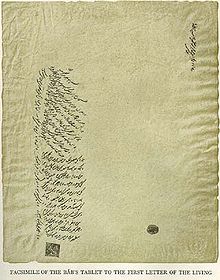- Mullá Husayn
-
Mullá Husayn-i Bushru'i (1813–1849) (Persian: ملا حسين بشروئي), titled Jináb-i-Bábu'l-Báb (Gate of the Gate), was a Persian religious figure, and the first Letter of the Living of the Bábí movement. He died at the Battle of Fort Shaykh Tabarsi, on February 2, 1849. His title of Bábu'l-Báb was bestowed upon him by the Báb.[1]
Contents
Background
Mullá Husayn was born with the given name of Muhammad Husayn Bushru'í in Búshrúyih (near Mashhad) to a wealthy and established family of the town.[2] His father Hájí Mullá `Abdu’lláh was a dyer; his mother was a poetess and known for her piety and knowledge.[2] Like most young boys of the era he received a haphazard education, learning a little scripture, reading, writing and basic mathematics.[2] At the age of 12 he left school and pursued higher education, which included lessons in Persian literature and the Quran, whilst mastering the art of debate.[2] By 21, he was already a mujtahid and whilst studying in Mashhad he became attracted to the teachings of Shaykh Ahmad and Shaykhism.[2]
Declaration of the Báb
According to Mulla Husayn, the Shaykhi leader, Sayyid Kazim, instructed his followers to spread out in search of the Qa'im.[3] On Siyyid Kazim's death, Mulla Husayn spent forty days secluded in prayer, after which he traveled to Bushehr and then to Shiraz.[4] There, on the 22nd of May, 1844, he encountered the Báb, who declared to Mulla Husayn that he was the expected Qa'im.[5][6] Mulla Husayn thus became the first of the Báb's followers.[6]
Notes
- ^ Zarandi, Nabil; translation by Shoghi Effendi (1996 Reprint). The Dawn-breakers. Wilmette, Illinois: Bahá'í Publishing Trust. pp. 63. ISBN 0-87743-020-9. http://reference.bahai.org/en/t/nz/DB/db-22.html#pg63.
- ^ a b c d e Mehrabkhani 1987
- ^ Zarandi (1932). The Dawn-Breakers. pp. 57. http://reference.bahai.org/en/t/nz/DB/db-22.html#pg57.
- ^ Sears, William (1960). Release the Sun. Wilmette, Illinois: Bahá'í Publishing Trust. pp. 9–11. ISBN 0-87743-003-9.
- ^ Encyclopædia Britannica (Retrieved November 10, 2009, from Encyclopædia Britannica Online). "the Bāb". http://www.britannica.com/EBchecked/topic/47304/the-Bab. Retrieved 2009-11-10.
- ^ a b Effendi, Shoghi (1974 edition). God Passes By. Wilmette, Illinois 60091: Bahá'í Publishing Trust. pp. 5. ISBN 0-87743-034-9. http://reference.bahai.org/en/t/se/GPB/gpb-2.html#pg5.
References
- Amanat, Abbas (1989). Resurrection and Renewal. Cornell University Press, New York, USA. ISBN 0801420989.
- Mehrabkhani, Ruhu'llah (1987). Mulla Husayn: Disciple at Dawn. Los Angeles: Kalimát Press. ISBN 0933770375. http://books.google.co.uk/books?id=wDYnPNwuwtcC&printsec=frontcover&source=gbs_v2_summary_r&cad=0#v=onepage&q=&f=false.
- Nabíl-i-Zarandí (1932). Shoghi Effendi (Translator). ed. The Dawn-Breakers: Nabíl’s Narrative (Hardcover ed.). Wilmette, Illinois, USA: Bahá'í Publishing Trust. ISBN 0900125225.
- Smith, Peter (1999). A Concise Encyclopedia of the Bahá'í Faith. Oxford, UK: Oneworld Publications. ISBN 1851681841.
External links
- Glossary of the Kitáb-i-Íqán - includes a small biography of Mullá Husayn
- Religious Systems of the World: A Contribution to the Study of Comparative Religion (London: Swann Sonnenschein), "The Bab", by Browne, E.G,pp. 335.
- Mullá Husayn, by Lowell Johnson
Categories:- Letters of the Living
- 1813 births
- 1849 deaths
- Shaykhism
- Bahá'í stubs
Wikimedia Foundation. 2010.


